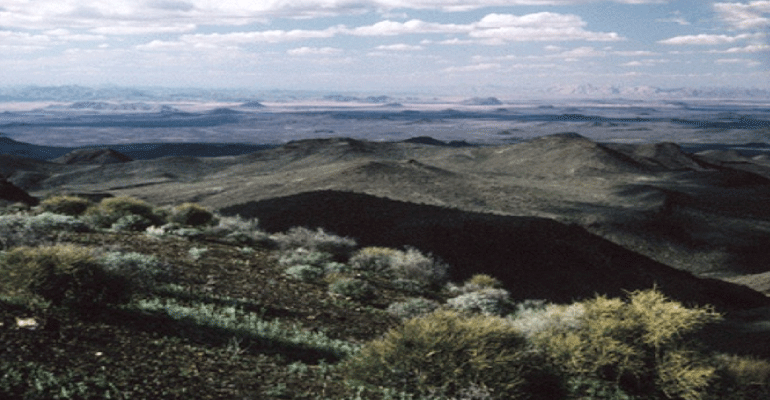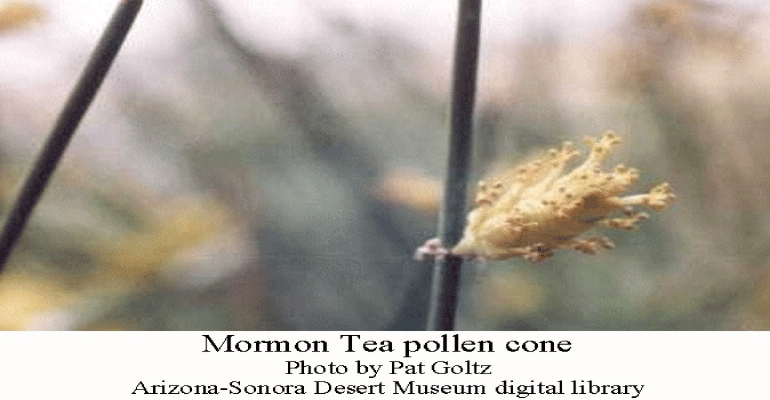
Mormon Tea (genus Ephedra) is a woody shrub that grows two to five feet high and wide. According to the Arizona-Sonora Desert Museum, “These are conifers more primitive than pine trees; they bear papery cones. (Their closest relative is the bizarre Welwitschia spp. of the Namib Desert, which looks like a beached green octopus but has the same cone structure as ephedra.) The various species are similar in general appearance; distinguishing among them requires close inspection.” There are about 40 species that occur in arid habitats in the northern hemisphere and South America. About six species occur in the Sonoran Desert region. Wikipedia shows a global distribution map for ephedra which includes a wide swath through Mediterranean Europe and south-central Asia. In some places in Mexico, such as the desert east of the Pinacate volcanic field, Ephedra plants reach 15 feet tall.
Ephedra has long been used medicinally, but there seems to be some controversy as to effectiveness and safety depending on species and source consulted. See this Fox News article.

ASDM notes: “The stems contain caffeine and ephedrine (a drug that acts like adrenalin/epinephrin). The closely related pseudoephedrine is now synthesized commercially and is an ingredient in commercial asthma and cold remedies, e.g., Sudafed®. Pseudoephedrine is also a precursor in the production of the dangerous illegal drug methamphetamine (“speed”). A tea with stimulant properties is made by steeping dried stems. It has been used medicinally to treat a variety of ailments including syphilis, diabetes, and pneumonia. A Chinese species is the source of ma huang, a tea so potent that it has caused deaths from overstimulation of the heart.”
DesertUSA describes several species: “This medium-sized shrub grows up to 4 feet high and appears to have no leaves. It looks like a thicket of numerous green, jointed, leafless branches with conspicuous nodes. It actually does have small, scale-like leaves and tiny flowers of male and female cones which bloom February through April. The fruit is a seed surrounded by 2 or 3 large scales. There are a number of species of Mormon Tea (Ephedra genus) growing in the southwestern deserts of the U.S., including E. trifurca, E. viridis, E. torreyana, E. nevadensis and E. californica. All have been used for a variety of medicinal purposes by various peoples over the centuries.”
WebMD notes: “Mormon tea is made from a plant, Ephedra nevadensis. The dried branches are boiled in water to make the tea. People use it as a beverage and as a medicine. Be careful not to confuse Mormon tea (Ephedra nevadensis) with ephedra (Ephedra sinica and other ephedra species). Unlike these other plants, Mormon tea does not contain ephedrine, an unsafe stimulant.
As a medicine, people take Mormon tea for sexually transmitted diseases such as syphilis and gonorrhea. It is also used for colds, kidney disorders, and as a ‘spring’ tonic.”
WebMD goes on to say: “The tannins in Mormon tea have a drying (astringent) effect and can reduce body secretions such as mucus. This might explain its use for colds. There isn’t enough information to know how Mormon tea might work for other uses such as kidney problems and sexually transmitted diseases. Mormon tea seems to be safe when consumed as a beverage in normal food amounts. But there isn’t enough information to know if Mormon tea is safe in medicinal amounts. Possible side effects include stomach complaints, kidney and liver damage, nose or throat cancer, increased urination, and constipation.”
See some good photos here and here.
Herb2000.com has an article specific to Ephedra nevadensis:
“From 1552 onwards, people have recommended taking Mormon tea as it is beneficial to our health. In effect, this herb and the tea brewed from it have been extensively used by frontiersmen to cure venereal or sexually transmitted diseases. In addition, Mormon tea has also been prescribed for treating conditions like colds and kidney problems as well as in the form of a ‘spring tonic’. Reputed herbal medicine physician David G. Spoerke has attributed the therapeutic actions of Mormon tea to an uncertain amount of alkaloid ephedrine enclosed by the herb. It may be noted here that this alkaloid ephedrine is a medication that facilitates the narrowing of the blood vessels, invigorating the central nervous system (CNS) as well as widening the bronchioles. On the other hand, Mowed, Gottlieb and Castleman have said that ephedrine is not the active constituent of Mormon tea – but its most active constituent is (+)-norpseudoephedrine, a much more strong stimulant for the central nervous system.”
The US Department of Agriculture has a good overview which includes a detailed description of the plants and their habitats. (see PDF file) USDA says that ephedrine, the pharmaceutically active compound found in the Old World species has not been detected in any North American species.
Here is the USDA description:
Ephedras are dioecious, with male and female cones occurring on separate plants. The cones are borne singly or in pairs or whorls at the branch nodes. The seeds are borne singly or in pairs in the axils of the female cone scales. The inner cone scales are modified to enclose the seed and form integuments that mimic the angiosperm pericarp. Flowering usually takes place in March through May, and seeds ripen from June through September, depending on elevation and species. The plants are wind-pollinated. Ephedra plants do not flower every year; their reproductive pattern could be described as mast fruiting, where most individuals in the population flower synchronously in a year with ample rainfall, and large quantities of seeds are produced. The population does not flower again for several years, whether or not a high-rainfall year occurs. The seedcrop may be damaged by late frosts, late spring drought, or infestations of pentatomid bugs.
The distribution of male and female ephedra plants is not random; individuals on dry slopes are over-represented by males, whereas those growing on run-on surfaces are 4 times as likely to be females as males. The genetic basis for sex differentiation in Ephedra is not known, but the spatial arrangement of males and females functions to maximize reproductive output, as it places males where their pollen can be easily wind-dispersed early in the season and females where they are more likely to have resources later in the season to ripen a seedcrop.
North American ephedra species fall into 2 groups characterized by differences in seed size and dispersal ecology. The large-seeded species (for example, green and Nevada Mormon-teas) are dispersed by scatter-hoarding rodents such as kangaroo rats, which deposit them in shallowly buried caches and later return to eat most of the seeds or sprouts. The cone scales in these species are small. In small-seeded species (for example, Torrey Mormon-tea) the outer cone scales are large and membranous, and the intact cones are often seen wind-rowed at some distance from adult plants. The seeds are apparently wind-dispersed, as they have long, awn-like points that probably make them unattractive to rodents. Cones with seeds intact may remain on the surface for many months.
Have any of you readers tried Mormon Tea? What does it taste like?
Related articles:
Chiltepin peppers, spice and medicine
Desert Broom – another medicinal plant
Desert Willows provide emergency food and medicine
Mesquite trees provide food, fuel, medicine, and more
Note to readers: I have constructed a linked index to more than 300 of my ADI articles. You can see it at: https://wryheat.wordpress.com/adi-index/
Have a look and see if there is some natural history subject of interest I haven’t yet written about
